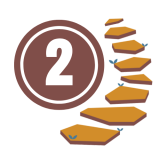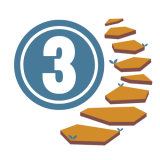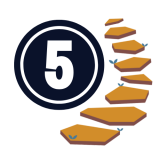Know that learning IS doing, and by expanding your knowledge and understanding you are taking important steps on your lifelong learning journey!
 Begin by orienting yourself with the communities around you
Begin by orienting yourself with the communities around you
Begin by orienting yourself with the communities around you: the treaties, the languages, and the land, and learn the traditional names to refer to those peoples and their languages wherever possible (i.e. Mohawk vs. Kanien'kehá:ka). An excellent resource you can use to learn about the land around you is Our Native Land which is also a great website to show to your students so that they can also learn and explore!
You can also find pre-made lessons
"that serve to teach students about the land they are learning on by viewing and creating original land acknowledgements and being introduced to complex topics concepts such as who Indigenous people are, what the term settler refers to, and notions such as broken promises and renewed commitments to share the land" (whose.land).
 Educate yourself about current terminology
Educate yourself about current terminology
Educate yourself about current terminology, as language is always evolving and it is important to be up to date on how different peoples wish to be identified. Also ensure that you have made the effort to learn about cultural safety before you tackle what can be quite heavy topics. You can learn more about how to walk with care in your classrooms as we have compiled helpful resources and suggestions for navigating these issues in your own learning/teaching journey.
 Consider using your platform to raise up Indigenous voices
Consider using your platform to raise up Indigenous voices
If there are topics you wish to cover regarding Indigenous history, or experiences, consider using your platform to raise up Indigenous voices by inviting an Indigenous guest speaker to come to your class to share their story. There are guest protocols that you should be aware of, which are important to follow, and you can learn more about those specifics on the guest protocols section of our website. You can also explore the different Indigenous communities of Quebec on our website here, which includes a detailed map and videos from the communities showcasing their unique identities.

Find creative ways to include Indigenous representation
Find creative ways to include Indigenous representation in your lesson plans—you might be surprised how many subjects can learn and improve from the inclusion of Indigenous Knowledges (IK) and worldviews. For ideas on different projects and lesson plans you can find examples and suggestions here in our curriculum section of the website. You will also discover arts-based and land-based projects that can help you get started.
 Create communities of practice
Create communities of practice
Create communities of practice and encourage other teachers to join you in learning more about Indigenous worldviews. Share your lesson plans with them and brainstorm new ways to adapt Quebec curriculum to incorporate IK. For example, in 2017, English- language Quebec college teachers and Indigenous community partners collaborated on the Intercollegiate Decolonizing Network. The IDN aims to create transformative education that “embraces Indigenous voices, knowledges and values for the well-being of all.” Their community of practice shares a wealth of resources on the IDN board, from curriculum and pedagogy to local events.

Advocate for Indigenous speakers and events
Advocate for Indigenous speakers, events, and other learning opportunities such as the KAIROS Blanket Exercise to be held at your school by raising these issues with your principal or leadership.